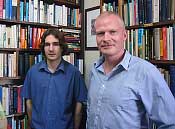By Coventry University.

It is generally believed that the texts were written in the 13th and 14th centuries by authors of unknown or uncertain identities but they may have oral prehistory. The texts focus on family histories and genealogies and reflect struggles and conflicts amongst the early settlers of Iceland and their descendants. The sagas describe many events in clear and plausible detail and are considered to be amongstthe gems of world literature and cultural inheritance.

They applied methods from statistical physics to social networks – in which nodes (connection points) represent individuals and links represent interactions between them – to hone in on the relationships between the characters and societies depicted therein.
The academics used the Sagas of Icelanders – a unique corpus of medieval literature from the period around the settlement of Iceland a thousand years ago – as the basis for their investigation.
Although the historicity of these tales is often questioned, some believe they may contain fictionalised distortions of real societies, and Mac Carron’s and Kenna’s research bolsters this hypothesis.
They mapped out the interactions between over 1,500 characters that appear in 18 sagas including five particularly famous epic tales. Their analyses show, for example, that although an ‘outlaw tale’ has similar properties to other European heroic epics, and the ‘family sagas’ of Icelandic literature are quite distinct, the overall network of saga society is consistent with real social networks.
Moreover, although it is acknowledged that J. R. R. Tolkien was strongly influenced by Nordic literature, the Viking sagas have a different network structure to the Lord of the Rings and other works of fiction.
Professor Ralph Kenna from Coventry University’s Applied Mathematics Research Centre said:
This quantitative investigation is very different to traditional approaches to comparative studies of ancient texts, which focus on qualitative aspects. Rather than individuals and events, the new approach looks at interactions and reveals new insights – that the Icelandic sagas have similar properties to those of real-world social networks.
On a wider level, the new approach shows that even after two centuries of scholarly examination, these sagas offer new knowledge if new techniques are applied and new questions asked.
This research demonstrates the importance of what interdisciplinary research between science and humanities can achieve.
The paper, Network analysis of the Íslendingasögur – the Sagas of Icelanders (European Physical Journal B 86 (2013) 407), is available to view online.


